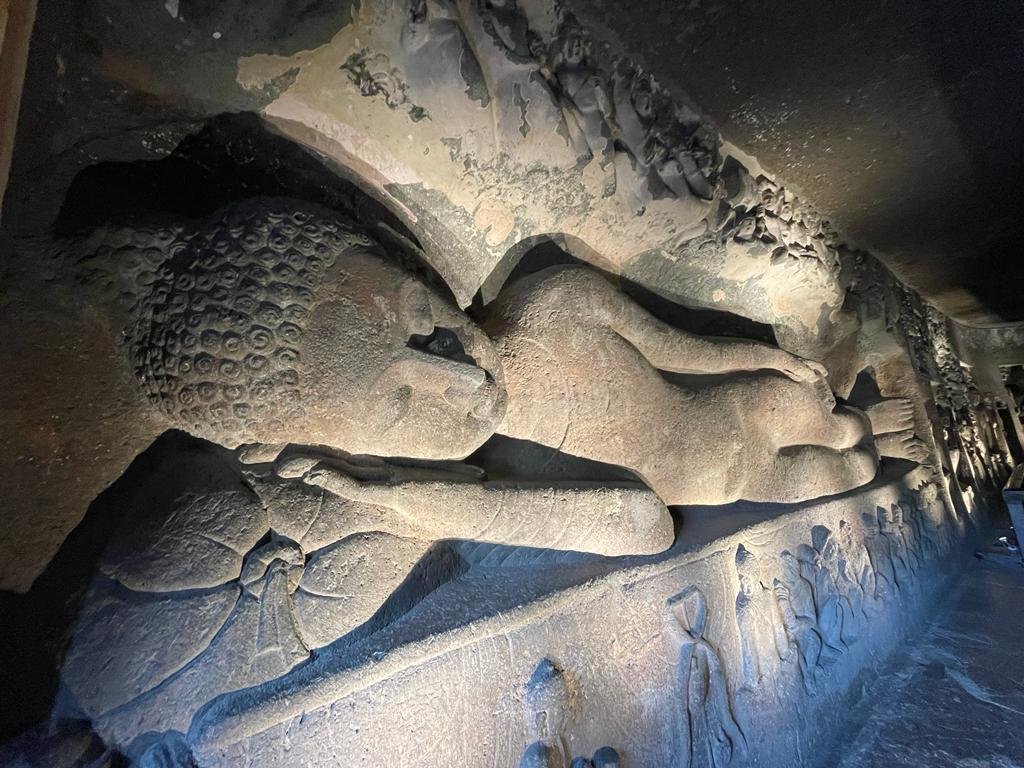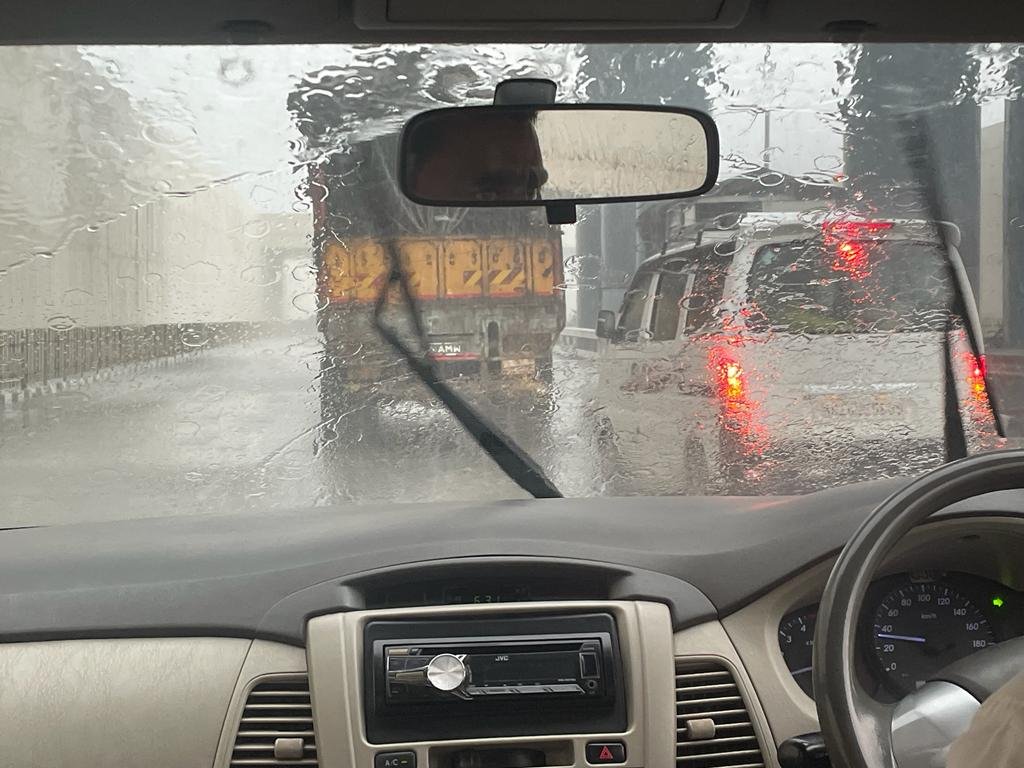Aurangabad and the Ajanta and Ellora Caves
Sunday 30 April – up early this morning at 3.45am – yes, you read that correctly. We have an Air India flight from Mumbai to Aurangabad at 7.00am!!
Aurangabad is located on a plateau on the hilly terrain of the Deccan Traps and the fifth most populous urban area in the Maharashtra region. It is a major production centre of cotton and silk fabrics. Off we went into the dead of night to the airport, no traffic was the only upside of leaving at this ungodly hour, but true to form, the airport was very busy. It took all of the two hours for queuing, security etc before we made it onto the plane for our one hour flight.
Another busy day ahead as once we dropped our bags off at the Vivanta Hotel, our guide and driver whisked us off immediately for the two hour drive to Ajanta and our visit to the incredible caves. What a drive, it was called a highway but it was anything but, rutted roads greeted us, we drove through one road that had been widened and this had been enabled by literally cutting off the front of some of the houses, passing a motorcyclist with a pillion rider holder two goats!!! It rained along the journey causing a huge lake of water on the other side of the road, we watched the poor motorcyclists having to try and ride through it, getting very wet, muddy, feet along the way. Passing lots of fields and various little townships, we stopped at the very salubrious (read dirty) Hilltop hotel, for lunch. We were allowed to use the bathroom of one of the rooms which was a real treat…I’m not going into any more detail than that…and we had to pay for the pleasure! Geoff gamely ordered a butter chicken curry but I settled for a tomato and onion omelette!
We finally arrived at Ajanta – another UNESCO World Heritage site, where it was necessary to park and then take a bus to the caves. I’m putting in a photo of the bus we got on – talk about bruised, dented and battered, and with filthy seats! I was concerned that it would have working brakes but was reassured by the fact we weren’t going down any hills.
A majestic sight greeted us in the form of 30 rock-cut Buddhist cave monuments dating from the 2nd Century BC literally hewn out of a 75 metre wall of basalt rock, which was surrounded by a jungle full of tigers. They are unbelievable! They were built in two phases, the first starting around the 2nd Century BC and the second around 400 to 650 AD. They constitute ancient monasteries known as Chaityas and have tiny cells with two rock ledges for beds, and worship halls known as Viharas, all with rock-cut sculptures of Buddhist deities done just with chisels and hammers – imagine that!
The rough surface was coated with a thick layer of clay and cow dung mixed with rice busks, the hard protective coverings of grains of rice. A final coat of lime was applied later on to produce a smooth polished surface onto which the artist painted using the prominent colours of yellow, red, blue, white, black and green. Most of the colours were obtained from minerals, except the black which was soot. Red and yellow were extracted from ochre or geru (a natural clay earth pigment which is a mixture of ferric oxide and varying amounts of clay and sand), green from glauconite or residues of volcanic rocks. Kaolin and gypsum were used for white and the blue was imported from central Asia from the lapis lazuli. The paintings present emotions through gesture, pose and form, depicting the past lives and rebirths of the Buddha. The paintings on the ceilings are purely decorative in nature, flowers, fruit, birds, animals, mythical animals and semi-divine beings. The mural paintings are narrative and religious in nature as they depict all the important events and legends related to the life of Buddha. They are among the finest surviving examples of ancient Indian art.
After the decline of Buddhism the caves of Ajanta were completely abandoned and forgotten by the world, but their rediscovery was very accidental and dramatic. In 1819 a British hunting party happened to visit the crescent valley of the Sahyadari ranges on a hunting expedition. A gentleman named John Smith sighted the upper part of the highest façade of Cave no 10 and reported to the Nizam of Hyderabad of his amazing discovery. The hidden treasures of the majestic fine arts were unveiled for the world to discover and John Smith was probably the first graffiti artist in the world as he has carved his name into the one of the pillars!
There is so much detail around this it would be impossible for me to blog about every cave but anyone wanting further information can google it or have a chat to Geoff, whose history knowledge is very impressive and he and the guide had a wonderful chat on the journeys to and from Ajanta.
The two hour return journey turned into a 3 ½ hour marathon although it was also a little exciting and another taste of how this amazing country works. Firstly, about an hour out, the heavens opened and our guide said that the rains were just like those during the monsoons. Like many other countries, global warming has also changed India’s weather pattern and it should be dry here until the monsoons start – exactly on 7 June! You couldn’t see out of the window, all those poor motorcycle riders, some with their whole families on one little scooter, mum, dad and two kids, were getting absolutely drenched and were desperately trying to find cover under bridges and shacks along the road.
Next, the rain abated and as we reached the town of Phulambi we got stuck in one humungous traffic jam. You’ve never seen anything like it. I mentioned in my first Mumbai blog that the driving here was unbelievably bad, but yesterday’s show took first prize. Coming into Phulambi the road had a division, two lanes each side with openings along the way for access to the side roads. The traffic jam was so bad, everyone undertaking, overtaking, pushing in and getting frustrated and driving on the other side of the road and then holding up the traffic in the other direction, especially when the cars on our side wouldn’t let them back in!
Absolute chaos reigned – there was a decorated wedding car with bride and bridesmaids on our right side, all looking beautiful in their finery, the kids waving madly at us (this bride was certainly late for her wedding!) and there were loads of men standing outside their shops and chai stalls watching the fiasco. Next minute we see plumes of pink smoke being shot into the air – turns out there were some local elections and the results were being read out. By the time we reached the election spot all we could see were men covered in pink dust!!!!! It was real theatre, luckily for us we were witnessing it from the comfort of our car with a very careful driver!
Dinner at the hotel was a buffet which comprised mainly of Indian cuisine and a chance to try out some local dishes. All very tasty and interesting to see that some of the dinner guests were wearing their pyjamas and slippers and a man was in his vest! Another great day with another wonderful set of experiences and adventure to match.












































